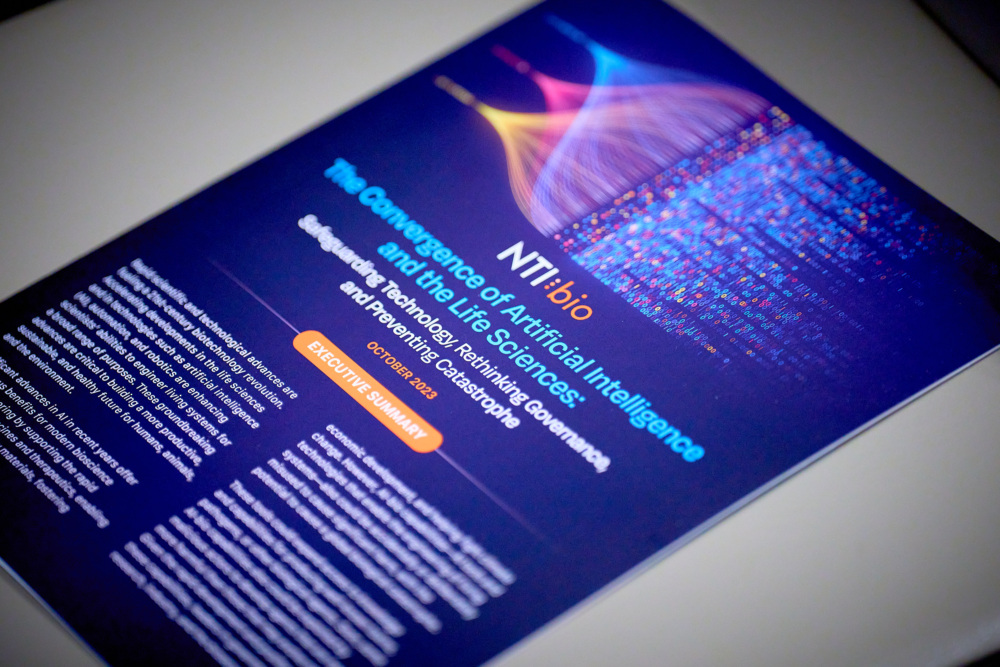
Common Mechanism to Prevent Illicit Gene Synthesis
In 2019, NTI and its Biosecurity Innovation and Risk Reduction Initiative partners launched five working groups to engage new stakeholders, identify urgent actions, and catalyze the adoption of new approaches to reduce biological risks associated with advances in technology. This page describes the working group on developing a Common Mechanism to Prevent Illicit Gene Synthesis, informed by a paper drafted ahead of the October 2018 Initiative launch. For more information about the other working groups, visit the Biosecurity Innovation and Risk Reduction Initiative project page.
Challenge: Cheaper and globally distributed nucleic acid synthesis technology increases the risk that malicious actors could misuse this technology to create and modify biological agents.
The incentives, standards, and technological approaches in place for screening
nucleic acids (DNA and RNA) have not kept up with the pace and reach of synthesis technology. Nucleic acid synthesis has quickly become a global industry, and most countries do not require companies operating within their territory to screen orders or customers. While members of the International Gene Synthesis Consortium (IGSC) voluntarily apply screening standards to assess gene sequence orders and customers, these companies today only represent approximately 80% of global commercial gene synthesis capacity.[1]
Companies that comply with the IGSC standards rely on implementing their own screening against lists of known pathogens, including organisms on the U.S. Select Agent List,[2] the Australia Group List,[3] and other national lists of regulated pathogens.[4] This screening mechanism is not robust enough to allow companies to assess orders based on the latest scientific knowledge that connects genetic sequence to causes of disease.
Further, the administrative burden associated with screening nucleic acid synthesis orders has markedly increased, creating strong disincentives for continuing and updating this practice in full. As the market for nucleic acid synthesis grows and the cost of synthesis itself decreases, the costs of the reviewing the requested sequences and associated customer screening follow-up become a larger percentage of the overall corporate cost of nucleic acid synthesis.
Additionally, in instances where screening identifies a potential nefarious use or user, many countries lack appropriate authorities to whom suppliers can report this activity.[5] In the United States, for example, commercial suppliers report such orders to the Federal Bureau of Investigation as recommended by 2010 guidance, but such direction is more the exception that the rule. [6]
To preserve safe and secure access to the DNA synthesis tools, it has become essential to revisit and improve screening of nucleic acid orders and customers to prevent misuse.
Proposed Solution: A common, globally accessible, and regularly updated mechanism to screen nucleic acid synthesis orders and customers.
A universal platform could be “virtually” housed in an existing or new organization or could be sustained by a networked approach. Financing the platform and ensuring appropriate connections with law enforcement agencies will be essential. Importantly, such a platform should prioritize protecting the benefits of new biotechnologies while at the same time mitigating risk, and its work should be consistent with the need to protect the proprietary information and technology of both nucleic acid synthesis companies and their customers.
Such a platform would provide:
- A secure and globally accessible system for screening nucleic acid synthesis orders;
- Global access and updates to screening algorithms that can identify emerging natural or engineered threats;
- A more affordable and sustainable way for existing nucleic acid synthesis companies to maintain a state-of-the-art screening system;
- Assurances for countries housing nucleic acid synthesis companies that they are complying with state-of-the-art security standards; and
- Opportunities for new synthesis companies to enter and compete in a secure synthesis market without forgoing security or developing their own screening capability.
Next Steps: NTI and the World Economic Forum (WEF) will convene a multi-stakeholder working group to develop requirements for a common screening mechanism to prevent illicit gene synthesis, and, if warranted, launch the platform for global use. The working group will: consider incentives for researchers to work with nucleic acid synthesis companies that adhere to the universal global mechanism; develop incentives for governments to adopt norms and enforce nucleic synthesis screening as a condition for nucleic synthesis companies to operate in country; and develop a roadmap to operationalize universal screening capacity.
[1] Harmonized screening protocol v2.0 (2017). International Gene Synthesis Corporation.
[2] U.S. Department of Health and Human Services and U.S. Department of Agriculture Select Agents and Toxins List (2018). 7CFR Part 331, 9 CFR Part 121, and 42 CFR Part 73, retrieved from https://www.selectagents.gov/SelectAgentsandToxinsList.html on 12 October 2018.
[3] The Australia Group (2017). List of human and animal pathogens and toxins for export control, retrieved from https://australiagroup.net/en/human_animal_pathogens.html on 12 October 2018.
[4] Harmonized screening protocol v2.0 (2017). International Gene Synthesis Corporation.
[5] DiEuliis, D., Carter, S.R., Gronvall, G.K. (2017). Options for synthetic DNA order screening, revisited. mSphere 2:e00319-17. https://doi.org/10.1128/mSphere.00319-17.
[6] U.S. Department of Health and Human Services (2010). Screening framework guidance for providers of synthetic double-stranded DNA. Retrieved from https://www.phe.gov/Preparedness/legal/guidance/syndna/Documents/syndna-guidance.pdf on 12 October 2018.
Stay Informed
Sign up for our newsletter to get the latest on nuclear and biological threats.

Financial Incentives for Biotechnology Investors to Improve Biosecurity
Biotechnology innovation now affects nearly every sector of the global economy.

The Convergence of Artificial Intelligence and the Life Sciences
New report from NTI | bio offers recommendations for urgent actions that leaders within government, industry, the scientific community, and civil society should take to safeguard AI-bio capabilities.
